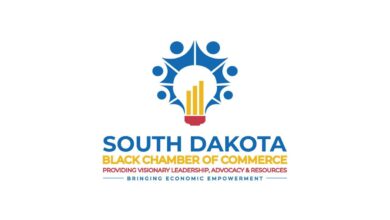Black population of Fargo-Moorhead has nearly tripled in past decade – Grand Forks Herald

Black population of Fargo-Moorhead has nearly tripled in past decade
By Grace Lyden
Forum News Service
FARGO — Chandra Smith has watched Fargo-Moorhead’s black population rise through the ledger of her weave shop.
As co-owner of Fargo’s Weaves of the World, Smith sells hair extensions primarily to black women, and starting a year and a half ago, business began to boom. She estimates it was up 20 percent for a time. Then came the competition.
Since September 2014, at least three new weave shops have opened in Fargo-Moorhead.
“With all the extra stores, we’re down now by 20 percent,” said Smith, 34, who moved to Fargo four years ago.
The expanding weave market is a sign of change for Fargo-Moorhead, with its historically low black population. Even today, the metro has a lower proportion of black residents than most similarly sized metros, according to census data.
Experts say this dates to the so-called Great Migration from 1910 to 1970, when Fargo’s distance from the South and lack of industry failed to attract black workers moving north.
But Fargo-Moorhead is beginning to see a reversal of its history.
The percentage of black residents in the metro has more than doubled in recent years — from 1.57 percent in 2006 to 3.79 percent in 2014, the most recent year of census data. Including people who are black in combination with other races, that’s a jump from 2,937 black residents to 8,654 — meaning the population almost tripled.
Some of the newcomers are refugees and immigrants, but many come from other areas of the United States. People of all races have been looking for jobs and hearing about opportunities in Fargo-Moorhead. As a result, the metro area is steadily becoming more diverse.
A new migration
Fargo-Moorhead has something to offer migrants today that it didn’t have during the Great Migration: jobs.
“Black people are going to move for the same reason white people do: opportunities,” said Aaron Renn, a senior fellow at the Manhattan Institute for Policy Research who has studied demographics of the Midwest. “Fargo, in general, is just doing very well economically.”
Renn has observed a recent movement of black (and white) workers away from the cities that attracted them during the Great Migration, such as Chicago, and back to the South or into the Great Plains, where economies are better.
“People are moving to places of opportunity, and quite often minorities are those who are leading the charge, particularly immigrants,” said Mark Schill, vice president for research at Praxis Strategy Group, an economic development firm based in Grand Forks.
Foreign-born blacks who aren’t multiracial comprised 48 percent of Fargo-Moorhead’s black population in 2014.
At 3.1 immigrants per 1,000 residents, Fargo-Moorhead has a higher immigration rate than Chicago or St. Louis, according to an analysis by Schill, who ranked metros by their average immigration rates from 2011 to 2014. Out of 381 areas, Fargo-Moorhead ranked 77th.
Likewise, Fargo-Moorhead ranked 27th in Schill’s analysis of domestic migration rates — a list that is “dominated by the nation’s most dynamic economies and high-amenity regions.”
Schill attributes these rankings to a shift in Fargo-Moorhead’s economy, which used to be regional and primarily agricultural but is now global and flush with opportunities in science, technology, engineering and math.
Following the 2008 recession, F-M became known for its jobs.
“The story’s out in the last five or 10 years,” Schill said.
The Rev. Reuben Duncan, 48, of Christ International Assembly in Fargo, can testify to the appeal of a good economy. Originally from Monrovia, Liberia, he said that’s why many immigrants come here.
The promises proved fruitful for Duncan, who is also co-owner of Manifold LLC (one of the new weave shops) and head of a nonprofit that helps the local Liberian community acclimate.
“I’ve been in this country 11 years, but I’ve never seen such prosperity and good people (as in Fargo),” he said.
Challenges remain
The rising population hasn’t gone unnoticed by local black residents.
“I’ve seen a lot of change,” said Cedric Allbritton, a 33-year-old master barber at Skill Cutz in Fargo, who’s been here close to nine years. Today, when he goes to the grocery store, “I see more faces, when before it was kind of like, ‘Am I the only one here?’ “
Eric Asa, an associate professor of construction management and engineering at North Dakota State University, echoed that.
“If you go to Walmart or if you go to Kohl’s and other places, you see lots of black kids working there, which is very encouraging,” said Asa, originally of Mamfe, Ghana, who’s been here since 2004. “It makes me also feel comfortable that I live life with other blacks here.”
That doesn’t mean it’s easy to live in a place where blacks comprise 3.79 percent of the population, compared to 13.85 percent of the country, as of 2014.
Among 30 metropolitan statistical areas that are closest in size to Fargo-Moorhead, just nine places reported a lower percentage of black residents in 2014.
When Mario Williams moved to Moorhead from San Diego in 2013, he was stunned by the lack of people who look him.
“I’m used to seeing more minorities in the area,” said the 20-year-old junior at Concordia College. “It was a big culture shock.”
On campus, women sometimes tell Williams they’ve “never seen a black guy before,” he said. And last year, while walking to a party off campus, he and his friends were attacked.
“As we were walking down the street, you know, a car drove by and said, ‘Go back to Africa,’ you know, called us all types of monkeys and then pelted us with eggs,” he said.
Nothing like that happened to Williams in San Diego, and he doubts it would have happened here if there were a larger black population.
Allbritton, too, said he sometimes feels like people here act strangely around him because of his race. Shortly after he came to Fargo, he went to a job interview with a man who was clearly intimidated by him.
“It was obvious he was nervous and looking the other way,” said Allbritton, who’s from the Chicago area. “It was just weird. That was the first time I experienced anything like that.”
Some, however, say they haven’t experienced any negativity as a result of living here.
In 11 years here, Asa has never been pulled over by Fargo or West Fargo police, though he was pulled over regularly when he lived in Moscow, Idaho.
“Most people around here are educated, so it makes it easy to integrate,” said Duncan, the Liberian pastor, who thinks the presence of so many colleges has made for an open-minded region. “I believe that almost everybody here understands about the real world.”
Regardless of personal experiences, all of the black residents interviewed for this article said they hope the numbers continue to grow, enriching Fargo-Moorhead with culture and new ideas.
Smith, the co-owner of Fargo’s Weaves of the World, wants her 4-year-old biracial son to grow up seeing diversity.
“It’s good for him to know that people come in all different shapes, sizes and colors,” she said. “There’s not only one type of people.”
The trend is likely to continue, as friends and family of current black residents hear the “good news” about Fargo-Moorhead, said Renn, the senior fellow at the Manhattan Institute.
“As people move and stay, then over time those networks become established,” he said. “To the extent that your economy keeps doing well and people are made to feel welcome, I would expect the flow would continue.”


























































